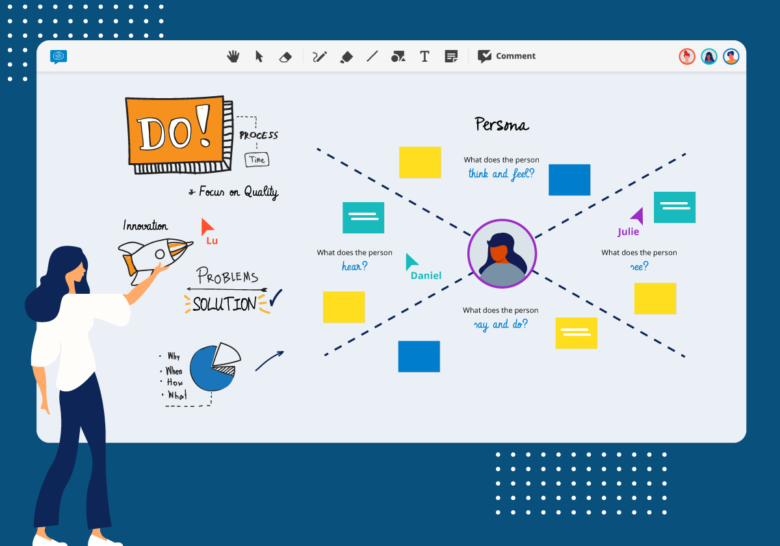In an increasingly digital world, the whiteboard, once limited to physical meeting rooms and classrooms, has undergone a significant transformation. Whiteboard tools are the digital counterparts of their physical ancestors and have become versatile and powerful platforms that promote creativity, collaboration and communication. These virtual whiteboards are already being used in various fields, from education and business to design and project management. In this article we explore the importance of whiteboard tools and how they can change the way we work, teach and brainstorm.
The evolution of whiteboard tools
The concept of whiteboard tools emerged from the need for remote collaboration and visual thinking, in an era where physical presence is no longer a prerequisite for meaningful interactions. These digital platforms take over the basic functions of a physical whiteboard, such as drawing, writing and erasing, while also incorporating modern technology to enhance their capabilities. This evolution is driven by the need for efficient remote working solutions and the desire to bridge geographic gaps.
Key features of whiteboard tools
Drawing and Writing: Whiteboard Tools provide a variety of drawing and writing tools, including pens, markers, shapes, and text, that help users illustrate ideas and concepts.
Real-time collaboration: Users can collaborate in real-time regardless of their physical location. Multiple participants can contribute to the whiteboard simultaneously, promoting teamwork.
Import and Export: These tools typically allow users to import images, documents, and files, making it easy to incorporate existing content into a whiteboard. Export options allow users to save and share their work.
Templates and widgets: Whiteboard tools often provide templates for different purposes, such as brainstorming, project planning, or education. Widgets such as sticky notes, charts and graphs enhance functionality.
Integrations: Many whiteboard tools integrate with popular collaboration platforms such as Microsoft Teams, Slack or Google Workspace, ensuring seamless connections to existing workflows.
Accessibility: Digital whiteboards can be accessed from a variety of devices, including computers, tablets and smartphones, making it easy for users to participate from anywhere.
Benefits of whiteboard tools
Enhance Creativity: Whiteboard tools provide a canvas for visual thinking, allowing users to express ideas, brainstorm ideas, and solve problems creatively.
Enhanced Collaboration: Real-time collaboration capabilities make it easy for teams to collaborate, share ideas, and provide instant feedback regardless of their physical location.
Ease of remote work: These tools are especially valuable for remote teams, allowing them to maintain a sense of connection and productivity despite being geographically separated.
Efficient Teaching: In the field of education, whiteboard tools have revolutionized online teaching. Teachers can engage students in interactive lessons and activities.
Project management: Whiteboarding tools play an important role in project planning and management, allowing teams to visualize tasks, timelines, and dependencies.
Environmental sustainability: The use of digital whiteboards reduces the need for physical materials and transportation, in line with sustainability efforts.
Choose the right whiteboard tool
Choosing the right whiteboard tool depends on your specific needs and goals. Consider factors such as team size, nature of the project, integration requirements and budget. Popular options include Miro, Microsoft Whiteboard, Jamboard, and Ziteboard.
Wrap Up
Whiteboard tools have become essential companions for those looking to unleash creativity and improve collaboration in an increasingly digital and remote world. They provide a virtual idea canvas that allows individuals and teams to brainstorm, plan and communicate visually. As demand for remote work solutions continues to grow and education and business adapt to the new reality, the role of whiteboarding tools in shaping the way we work, teach and innovate will continue to grow. These digital whiteboards are more than tools; They are catalysts of imagination and collaboration, promoting a more connected and creative world.





Comments
This is a very good move, we appreciate it.
Great….. An interactive whiteboard is a great tool for engaging students, promoting collaborative learning and improving retention. It can be used to create a real-life, hands-on experience that is not possible with other more traditional forms of learning.
thanks for your kind information.